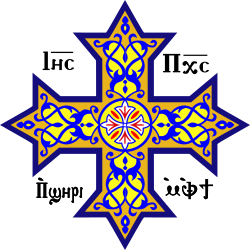History
Following the execution of Saint Mina, his sister brought his body to a church in Alexandria. When the time of persecution ended, during the papacy of Pope Athanasius of Alexandria, an angel appeared to the Pope and ordered him to load the saint's body on a camel and head towards the Western Desert. At a certain spot near a water well at the end of Lake Mariout, not far from Alexandria, the camel stopped and wouldn't move. The Christians took this a sign from God and there buried Saint Mina's body after placing it in a silver coffin. The coffin was later placed inside decay-resistant wood and buried at the same location.
Most versions of the story state that the location of the tomb was then forgotten until its miraculous rediscovery by a local shepherd. A shepherd was feeding his sheep in that location, and a sick lamb fell on the ground. As it struggled to get on its feet again, its scab was cured. The story spread quickly and the sick who came to this spot recovered from whatever illnesses they had just by lying on the ground. The Ethiopian Synaxarium describes Constantine I sending his sick daughter to the shepherd to be cured, and credits her with finding Mina's body, after which Constantine ordered the construction of a church at the site. Some versions of the story replace Constantine with the late-5th century emperor Zeno, but archaeologists have dated the original foundation to the late 4th century. [1] According to the Zeno version, his daughter was leprous and his advisors suggested that she should try that place, and she did. At night Saint Mina appeared to the girl and informed her that his body was buried in that place. The following morning, Zeno's daughter was cured and she related her vision about the saint to her servants. Zeno immediately ordered Mina's body to be dug out and a cathedral to be built there.
A large city was also built there and named after the saint. Sick people from all over the world used to visit that city and were healed through the intercessions of Saint Mina, who became known as the Wonders' Maker. Today, numerous little clay bottles on which the saint's name and picture are engraved are found by archeologists in diverse countries around the Mediterranean world, such as Heidelberg in Germany, Milan in Italy, Dalmatia in Croatia, Marseille in France, Dongola in Sudan, and the holy city of Jerusalem. Visitors would buy these bottles, usually containing oil or water for blessing, and take them back to their relatives.
This page is based on this
Wikipedia article Text is available under the
CC BY-SA 4.0 license; additional terms may apply.
Images, videos and audio are available under their respective licenses.




